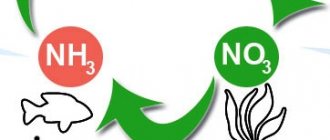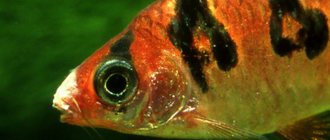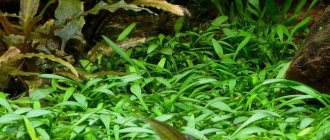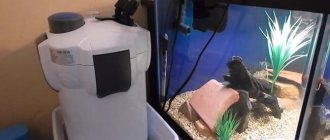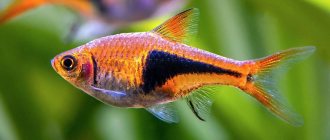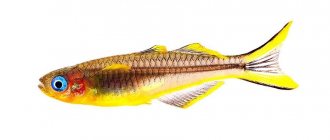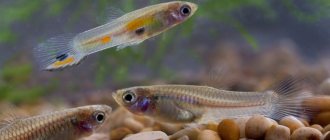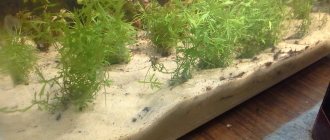For example, the release of oxygen in the light by algae and its absorption in the process of respiration by shrimp. The mathematical model of this process is very complex and describes the movement of macro and microelements. There is no direct solution to this problem yet. Therefore, we resorted to a trick: all living systems can stabilize themselves, therefore, if you create a balance in some elements, for example, oxygen, then the remaining elements will stabilize themselves.
Optimal for the functioning of an aquatic ecosystem is the balance of the processes of production and destruction (P: D = 1). In a eutrophicated reservoir P:D>1, i.e. There is an excessive accumulation of organic matter due to an excess of nutrients. When a reservoir is overloaded with organic substances from outside, P<D, in clean waters, as already indicated, the processes are balanced, P=D.
Thus, the ratio of the values of oxygen production and its use in destruction processes is one of the integral indicators of the sanitary and biological state of the ecosystem and water quality.
Types of ecosystems and their features
An ecosystem is a collection of living organisms of various species in a certain area of the biosphere, which are connected not only with each other, but also with the components of inanimate nature through the circulation of substances and energy conversion. It can be natural and artificial.
Natural ecosystems (forests, steppes, savannas, lakes, seas and others) are a self-regulating structure. Artificial ecosystems (agrocenosis, aquariums and others) are created and maintained by humans.
Testing similar closed aquariums in space at the Russian MIR station!
A sealed aquarium in the form of a cylinder was tested at the Russian Mir station. The tests were successful.
A Russian cosmonaut demonstrates an aquarium. Because There is zero gravity at the station, then air bubbles float inside the aquarium.
What do our aquariums look like? |
— “AquaMir - amphora”, a completely closed, maintenance-free, living aquarium.
— “AquaMir - Egg”, a completely closed, maintenance-free, live aquarium.
— “AquaMir - Egg”, a completely closed, maintenance-free, live aquarium.
You can see more photos here: Our first achievements in the field of aquarium farming.
Ecosystem structure
In ecology, the ecosystem is the main functional unit. It includes the inanimate environment and organisms as components that mutually influence each other’s properties. Its structure, regardless of the type, be it the ecosystem of a natural reservoir or the ecosystem of an aquarium, includes the following components:
- Spatial - placement of organisms in a specific biological system.
- Species - the number of living species and the ratio of their numbers.
- Community components: abiotic (inanimate nature) and biotic (organisms - consumers, producers and destroyers).
- The circulation of matter and energy is an important condition for the existence of an ecosystem.
- The stability of an ecosystem, depending on the number of species living in it and the length of the food chains formed.
Let's consider an example of one of the biological systems - an aquarium. Its artificial ecosystem includes all structural units. An aquarium of a certain size (spatial arrangement) contains a living component of the system (fish, plants, microorganisms). Its components also include water, soil, and driftwood. An aquarium is a closed ecosystem, so conditions close to natural ones are artificially created for its inhabitants. Why is lighting used, since nothing living can fully develop and live without light; thermoregulation - to maintain a constant temperature level; aeration and filtration - to supply oxygen to the water and constantly purify it.
Individual project “Aquarium - closed system”
Rice.
8 Digital Biome Terrarium A closed ecosystem with controlled conditions has been created inside it. The terrarium connects remotely to a tablet or laptop. All parameters inside the flask are displayed on a convenient interface, and with just one click of a button you can adjust the light, water or add nutrients to the soil. But in reality everything is much simpler!
8
Practical part
To create an ecosystem in a sealed vessel you will need:
1. Plants
What to choose? The most suitable options are moss, tradescantia, small sprouts of chlorophytum and fern. You can use other plants, the main selection criteria are slow growth, unpretentiousness and compatibility of plants with each other. For example, cactus and moss are unlikely to get along in the same vessel.
My option: moss, clover and a couple of small sprouts of knotweed dug up in the park (purely as an experiment), as well as soleirolia bought in a store, which also loves moist air and does not favor direct sunlight.
2.Vessels
It all depends only on your imagination and capabilities. You can choose anything from the notorious light bulbs to huge bottles. I even saw an option online with a two-liter plastic bottle. The main thing is that it can be sealed. For these purposes, I took a 500 ml chemical flask and a kitchen jar for bulk products.
3. Soil and drainage
You can use universal soil for indoor plants, or, if you only take plants from the street, dig up the soil in which they originally grew. I dug up the clover along with a piece of earth into which the roots had sprouted.
Drainage - expanded clay, fine gravel or crushed stone, pieces of ceramics. In general, any material that does not rot and does not retain water. Sand is optional.
4. Stopper/cap and sealant
If your vessel is sealed tightly with a stopper, then no sealant is needed.
5. Decor - optional
Again, whatever suits your taste. The main thing is not to rot.
Now about the manufacturing process.
9
First of all, pour drainage into the vessel. The amount depends on the size of the vessel and the type of plant: the smaller the vessel and the more moisture-loving the plant, the less drainage is needed and vice versa. For a vessel with a volume of 0.5 liters and plants such as moss, a layer of 1.5-2 cm will be sufficient. It can be covered with a small layer of sand on top so that the soil does not mix with the drainage. If you use a tall flask with a narrow neck, you need to fill the drainage carefully and, preferably, using some kind of tool such as a spoon or gutter, so as not to damage the bottom.
Next we fill in the soil. The layer depends on the type of plant. Moss, for example, does not require a lot of soil, but plants with a developed root system will need a layer depending on their size. In my case, 1 cm was quite enough for a jar (there will be clover with its own soil and moss) and about 1.5 cm for a flask (in addition to moss, I will plant saltwort there).
I placed a few more pebbles on top of the soil just like that. Wide neck - less problems.
10
Now you can plant the plants. We simply place the moss on the ground and press it lightly; for other plants we make holes in the ground, place the roots in it and cover it with soil. You can compact the soil on top a little, but only a little. For vessels with a narrow neck, long tweezers or a pair of chopsticks and the skill of eating sushi will be very useful.
The contents of the flask seemed too dull to me, so I decided to dilute the landscape with a homemade sign made of polymer clay (“plates” are made of polymer and glued with superglue to a toothpick, everything is painted with acrylic, this will be sufficient moisture insulation for the toothpick
11
Next, the whole thing needs to be watered. The amount of water can only be determined experimentally, and this is perhaps the most difficult moment. In order for such an ecosystem to please you for a long time, the amount of water must be sufficient for plant life, but not too much so that the contents do not turn into a swamp. I would advise you to keep your plants unclogged for a day after the first watering, then close the lid tightly and leave for another 12 hours. After that, look at the situation inside.
For example, for moss: if the inside walls are very foggy (a dense fog formed in my jar the next morning after sealing, and there was a layer of water on the stones), you need to open the lid again and let the water evaporate; If the walls are not fogged up at all, you need to water a little more. During experiments with water, by the way, it will become clear whether your plants have taken root
When you decide that you have selected the optimal amount of water, the vessel can be sealed completely. To do this, the lid or plug can be coated with sealant or hot melt adhesive.
That's all, actually.
12
2.1Aquarium with a closed ecosystem
Using the example of our planet, which is a closed system with living organisms, miniature biosystems were created based on the results of space and bioexperiments of the former Soviet Union and the United States. Consider an aquarium with a closed ecosystem.
The ball, comparable in size to an orange, was filled with sea shrimp. The atmosphere of the ocean floor is recreated there, using ocean sand, shells, and pebbles. The ball is sealed. The supply of air, water, and feed is excluded. Microalgae release oxygen when exposed to light (photosynthesis). Particles of these plants serve as food for shrimp.
Shrimp produce carbon dioxide, which is necessary for algae; their waste products fertilize aquatic plants. Analogues of such aquariums participated in experiments on the American Shuttle and the Russian space station Mir. In an aquarium with a closed aqua system, you can see the movements of shrimp, their walking and feeding, nipping at their own kind, as well as the transfer of small grains of sand by shrimp! They react to outside disturbance by temporarily losing their red color, changing color to match their environment.
Over time, having calmed down, the shrimp return to their natural red light. It has been noticed that some shrimp exhibit constant colorlessness, while they feel quite comfortable. Conditions for reproduction in such aquariums have not been created, so cases of reproduction are extremely rare. You should not buy an aquarium with a closed ecosystem in which there are more than two shrimp, they will not be able to live long, since the self-cleaning system is not designed for more than that.
13
In such an aquarium, shrimp are freed from enemies and live up to about ten years. It happens that the ecosystem lives up to 12 years. The lifespan of this closed ecosystem is determined by the life expectancy of the shrimp. Shrimp in an aquarium are of different ages, so if one dies, the other will also die.
14
2.2 Aquaponics
In some countries, in recent years, a new type of agricultural enterprises have been created - farms of the future, which use a new method of organizing agriculture - aquaponics - a unified system for growing freshwater animals and agricultural crops.
The essence of the method is the complete absence of natural soil on aquafarms, and the use of waste from various freshwater animals: fish, shrimp and others to feed green plant matter.
In addition, by using waste products of aquatic organisms as food, plants purify water from contaminants and saturate it with oxygen.
In the British city of Bristol, an aquaponics farm has been operating for several years, growing various vitamin-rich greens: lettuce, parsley, dill. Specialists in it work according to a closed scheme:
feeding fish - caring for beds - harvesting
An aquaponics system involves two containers: one for breeding fish, and the other, installed directly above the first, serves directly for growing plants on artificial soil.
Fish waste products are an ideal fertilizer for many plants: vegetables, flowers and herbs.
15
In the process of aquaponics, bacteria play an important role, which purify water for animals from toxic substances, converting them into fertilizers necessary for feeding vegetation.
Aquaponics has made it possible to free ourselves from the use of herbicides and pesticides, which are destructive to the life of bacteria and animals.
At the aqua farm, there is a constant circulation of water, which is constantly pumped using pumps from a container with fish to a container for plants, and then, already purified, is returned to the fish again.
The most commonly grown animals on agricultural farms are carp, common crayfish and edible frogs.
Aquaponics - a unified system for growing freshwater animals and agricultural crops - attracts the attention of agricultural specialists around the world.
16
Conclusion
- Self-created closed ecosystems are an excellent teaching tool for developing observation and attention, which is the basis for solving various problems.
- The problem of ecology in modern society remains relevant to this day. The need to create closed ecosystems now represents not only a purely scientific, but also a vital problem.
17
Literature and sources
Internet resources:
- https://aquariumsworld.ru/akvarium-s-zamknutoj-ekosistemoj/
- https://aqvafish.ru
- https://www.chaoslend.ru/node/868
- https://fishki.net/1943262-zamknutaja-jekosistema-svoimi-rukami-moyo.html
- https://interesnii-fakt.ru/udivitelnye-otkrytiya-i-izobreteniya/akvaponika-edinaya-sistema-vyrashhivaniya-presnovodnyx-zhivotnyx-i-selskoxozyajstvennnnyx-kulturnyx-rastenij-video
- https://www.porjati.ru/kreativ/68873-florarium-ili-sad-v-butylke.html
- https://ru.wikipedia.org/wiki/Florarium
18
Differences between ecosystems
At first glance, it may seem that the ecosystem of an aquarium is not much different from a natural body of water. After all, the aquarium itself is a kind of small copy of an enclosed reservoir intended for keeping and breeding fish and plants. Life in it proceeds according to similar biological processes. Only an aquarium is a small artificial ecosystem. In it, the degree of influence of abiotic components (temperature, light, water hardness, pH and others) on biotic components is balanced by humans. It also supports all the necessary life activity in the aquarium, the duration of which largely depends on the experience of the aquarist and his ability to control the balance of the environment. However, even with proper care, it periodically falls into disrepair, and a person will have to patiently rebuild it in an indoor pond. Why is this happening?
Nano aquarium design
Small volumes require careful design. All design elements must be harmoniously combined and complement each other.
Priming
Selection of soil is a serious stage of design.
If algae are planned in a microaquarium, then they need to be provided with a nutritious substrate, on top of which coarse sand or finely ground gravel .
Scenery
The decorations are designed to emphasize the individuality of the aquarium and create its unique inner world.
The small volume does not allow working with large elements, but small stones or driftwood, shards and amphorae can solve the problem of design.
Decorative elements made of plastic (ship wrecks or castle ruins) well into microaquariums
Flora
Plants in a small aquarium are the key to the formation of a stable ecosystem.
There are a number of nuances in choosing algae that are best taken into account in advance:
- The water in the microaquarium warms up evenly and quickly, which stimulates the active growth of algae.
- You should not add plants with large leaves to a small pond - they will very quickly fill the entire space, and there will be no room left for the fish.
Experienced aquascapers recommend choosing compact plants for microaquariums :
- various types of mosses for a nanoaquarium;
- small ferns;
- small varieties of cryptocorynes;
- dwarf sedge and other small plants.
Important! Small algae and mosses have a slow growth rate, which is ideal for a micro aquarium.
Causal factors
The ecosystem of an aquarium depends on the age of its aquatic environment. It goes through the stages of formation, youth, maturity and degradation. Few plants can withstand imbalances in the ecosystem, and fish stop reproducing.
The size of the aquarium also plays a significant role. The lifespan of the medium directly depends on its volume. It is similar to an ecosystem in nature. It is known that the larger the volume of a reservoir, the greater its resistance to disturbances of the necessary equilibrium. In an aquarium of up to 200 liters, it is not difficult to create a habitat close to natural, but it is much more difficult to upset the balance in it with your inept actions.
Aquariums with a small capacity of up to 30-40 liters require regular water changes. Within reasonable limits, changing it by 1/3-1/5 can shake the equilibrium stability, but the environment is restored after a couple of days on its own, but if all the water is replaced, the established balance can easily be upset.
The aquarist should know that, having formed an ecosystem, it is necessary to maintain balance in it with minimal intervention.
Equipment
Lighting is very important for the formation of a sustainable ecosystem. Direct sunlight is not suitable for prolonged illumination of an aquarium.
It is better to choose a container with built-in lighting , which can be turned on and off if necessary.
The small size of the tank requires careful temperature control: both heating and cooling of the water in them is rapid, and this has a detrimental effect on the health of the inhabitants. Therefore, it is important to choose the right thermometer.
The microaquarium must be equipped with a compressor. It is not difficult to calculate the required power: the minimum productivity is 0.5 l/h for each liter of water.
For medium and large tanks, choose a device with a small margin (for example, for 400 liters, not 200 l/h, but 250), but for aeration of a small volume, a unit with minimal capacity is quite suitable .
A filter is required to remove toxic compounds. Choose a compact model, because it will need to pass a small volume of liquid.
In addition, to maintain the aquarium you will need:
- glass scrapers;
- siphon;
- net;
- tweezers.
can be a good alternative to a self-assembled pond - this is a German line of ready-made aqua systems , equipped with everything necessary for successful operation.
Ecological system model
An aquarium is a small artificial ecosystem, the structure of which differs little from the natural one. The components of an ecosystem are a biotope and a biocenosis. In an aquarium, the inorganic nature (biotope) is water, soil, and their properties. It also includes the volume of space in the aquatic environment, its mobility, temperature, illumination and other parameters. The necessary properties of the environment are created and maintained by humans. He feeds the inhabitants of the aquarium and takes care of the cleanliness of the soil and water. Thus, it creates only a model of the ecosystem. In nature, she is closed and independent.
Fish and shrimp
As mentioned above, keeping shrimp in a community aquarium is undesirable. Most fish happily hunt small crustaceans. An exception is the chain-mailed herbivorous catfish (Ancistrus, Otocinclus), their mouthparts are designed for scraping off algal growths, not for eating animal food. Reproduction of shrimp in a community aquarium is also hardly possible due to constant stress. In addition, freshly molted and young shrimp will become especially desirable prey for fish.
Abiotic factors
The natural totality is distinguished by much deeper relationships and interdependencies. In a home pond they are regulated by humans. Conventionally, in a home pond, all living organisms are called an aquarium biocenosis. They occupy certain ecological niches in it, creating harmony of habitat. Favorable conditions for life are created for them taking into account abiotic factors - appropriate temperature, lighting and water movement.
The temperature depends on the inhabitants of the aquarium. Since even minor changes in temperature can lead to the death of some fish species, it is recommended to use heaters with a built-in thermostat.
The lighting mode is necessary for the normal functioning of all components of the aquarium environment. Light sources are usually located above the surface of the water. The length of daylight hours must correspond to the photoperiod of the inhabitants in their natural living conditions.
In nature, standing water is more mobile due to the influence of rain, wind and other disturbances. The aquarium requires constant circulation of water. This is achieved by aeration or running water through a filter.
Constant circulation ensures vertical rotation of water in the aquarium. It also levels out the acidity level and prevents a rapid decrease in the redox potential in the bottom layers.
Plants in a shrimp tank
You can often see photos of an aquarium with shrimp, where the decorative nature of the mini-reservoir is emphasized by dense thickets of plants. In fact, shrimp have no need for plants, because they use most of the resources for the development of bacteria and algae, and all this is exactly what the shrimp eat in the aquarium.
In such cases, even with additional feeding, the crustaceans do not receive enough substances important for health and may die. A shrimp tank with a layer of leaves at the bottom where microorganisms will develop is considered ideal. Although we must admit that it does not look particularly aesthetically pleasing and causes difficulties in how to catch shrimp from the aquarium.
If you are choosing plants for a shrimp tank, then it is better to focus on slow-growing varieties: aquatic ferns, cladophora, mosses.
It is strictly forbidden to use fertilizers for plants; freshwater shrimp for aquariums perceive them as poison and will most likely die.
Organic and inorganic compounds
Water, oxygen, carbon dioxide, amino acids, nitrogen and phosphorus salts, humic acids are the main organic and inorganic compounds that also belong to abiotic elements. Most of them are contained in the aquarium organisms themselves and in bottom sediments.
The rate of transition of these nutrients into aqueous solution is ensured as a result of the functioning of producers and decomposers of the ecosystem. Organic nitrogen-containing secretions are utilized by bacteria, turning them into simpler substances necessary for absorption by plants. Organic compounds are also converted into mineral (inorganic) form by different types of bacteria. These important processes depend on the temperature of the water, its acidity, and oxygen saturation. They regulate the normal functioning of the ecosystem.
When creating a closed aquarium ecosystem, it is important to know that it is ready to receive its inhabitants, but is not completely balanced, since many important types of bacteria stabilize within two weeks.
Photo of shrimp
Shrimp Malaya
White bee
Orange bee
golden bee
Blue tiger shrimp
Red tiger shrimp
Black crystal
Tiger shrimp
Neocaridina palmata
Neocardina "Mini Japanica"
Blue Pearl Shrimp
Snowball shrimp, white pearl
Neocaridina (wild form)
Glass shrimp
Athyopsis, banana shrimp
Tiger shrimp
Bumblebee shrimp
Shrimp Red Crystal
Rednose shrimp
Shrimp Cardinal
Shrimp Amano
Purple Zebra Shrimp
Ninja Shrimp
European shrimp
Red Tupfel Shrimp
Green shrimp
Yellow shrimp
Cherry shrimp
Blue Bee Shrimp
Blue-footed bee from Poso
Rhino shrimp
Glass ghost shrimp
Sand shrimp
Riley shrimp
Ecosystem stability and the cycle of substances in the aquarium
The inhabitants of the aquarium cannot ensure a complete cycle of substances. It reveals a break in the chain between consumers and producers. This is facilitated by the closed ecosystem of the aquarium. Shrimp, mollusks, crustaceans (consumers) eat plants (producers), but no one eats the consumers themselves. The chain is interrupted. At the same time, another fish food chain—bloodworms and other food—is artificially maintained by humans.
It is quite difficult to create conditions for keeping the required number of daphnia and cyclops in an aquarium for feeding fish. Since these small crustaceans, in turn, also need food. The life of protozoa depends on the presence of organic substances in the aquarium. The number of ciliates should exceed the number of crustaceans, the latter, in turn, should be kept in a greater proportion to fish. Such balance in food chains is difficult to achieve in spatial conditions such as a closed aquarium. Its ecosystem does not contribute to supporting quantitative indicators of environmental factors at certain levels.
In natural ecosystems, each species is balanced in relation to other species. Each of them occupies its own niche and determines the interdependence of species. The proportions of predators and their prey in the development of an ecosystem are strictly balanced. Such balancing cannot be achieved in such a confined space as an aquarium. An artificial ecosystem requires a competent selection of its inhabitants. The ecological niches of fish and plants should be compatible, but not overlap one another. They are selected so that their life needs and so-called “professions” (consumers, producers and destroyers) are not to the detriment of others.
A balanced selection of inhabitants according to their “professional” purpose in a model of an aquarium ecosystem is the most important condition for its long-term health.
Fish for nanoaquariums
The most common inhabitants of microaquariums are freshwater shrimp and snails , but fish are no less often found in artificial reservoirs of small capacity.
The most popular inhabitants of micro aquariums are 9 varieties of aquarium fish that do not require much space.
Various types of microdisassembly
These small fish, up to 3 cm in length, gray-black in color with bright pigment dots, perfectly adapt to the small size of the tank. They feel good and can give birth.
Danio
In general, these are very active fish and they require a certain amount of space, but if you choose a small aquarium with an elongated shape, zebrafish are quite adaptable to its size.
Guppy
Even those who are far from aquarium hobby have heard about these fish. Unpretentious fish are suitable for both beginning aquarists and experienced breeders.
There are collectors who specialize in certain breeds of goosefish and are ready to talk for hours about their advantages over other fish.
Miniature catfish
A reservoir of 10 liters or more with a loose substrate is suitable for their maintenance - catfish will happily rummage through it in search of food.
They feel comfortable in small flocks of 4–5 individuals, but for a species aquarium it is better to start a flock of 13–15 individuals.
Important! Be sure to provide shelter for catfish - driftwood, stones or amphorae.
Small species of iris
Very beautiful and unusual bright fish with a bizarre body shape and fins.
They are peaceful, extremely unpretentious, and are able to peacefully coexist with most species of other aquarium inhabitants.
Small tetras
The fish are small and feel good in a small reservoir, but you need to keep in mind that they are school dwellers.
Therefore, it is better to immediately introduce a flock of 5-6 individuals into the aquarium.
Cockerels
Real favorites of micro aquariums. They can live even in a tiny 5-liter tank, but you shouldn’t put a school of these fish in such a small space.
Eleotis carpet
The fish are unpretentious, peaceful and calm. For a comfortable existence, they need shelters where they spend most of the day.
Bee goby or bumblebee goby
An interesting small fish (up to 3.5 cm) with a characteristic striped coloring - it was this that gave the name to the species.
Experienced aquarists keep gobies in brackish water, but in a balanced microclimate, gobies tolerate fresh water well. They love a lot of hiding places. Unpretentious.
You can select other inhabitants for the nanoaquarium or create only a plant pond - there are many options.
If desired, with due effort, you will receive a magnificent micro aquarium , which will decorate both home and office interiors.
"Address" of the inhabitants of the aquarium
The habitat in the reservoir of each species is also of considerable importance. They all must find a suitable home. You should not oversaturate the aquarium, so as not to lead to the degradation of other species. Thus, floating plants, growing, block the light of algae growing below, the lack of shelters on the bottom and habitats for bottom-dwelling fish species leads to skirmishes and the death of weaker individuals.
It is also important to remember that all animals and plants are constantly changing, which, accordingly, cannot but affect their environment. It is necessary to monitor the behavior of the fish, not to overfeed them, care for the plants, cut off their rotten areas, and keep the soil clean.
To maintain the stability of the ecosystem in the aquarium, it is necessary to think about any attempts to intervene whether this will harm the balance.
Launch rules
This is not to say that launching a nanoaquarium (30 liters) is an overwhelming task, but several factors need to be taken into account :
- There should be no central heating systems in the immediate vicinity of the tank (remember, the mini-aquarium heats up very quickly).
- The reservoir should not be exposed to direct sunlight. It is also advisable to exclude drafts.
- The surface where the microaquarium is located must be flat; it is ideal to install a special cabinet and/or stand - they will allow you to place all the necessary equipment.
Important! Provide free access to the aquarium so that you can maintain it without interference.
Before starting the aquarium, be sure to wash it using baking soda . This will remove any remaining glue or lubricants that were used in the production of the container.
You should not use chemical detergents or abrasive substances - traces of them may remain in the water, which will lead to the death of the inhabitants.
The soil and decorations are also thoroughly washed before installation. Then fill the aquarium 3/4 of the volume and let the water settle.
Around the second day the water will become cloudy - this is normal. The process is clear evidence that bacteria have begun to act in the reservoir.
After 2–3 weeks, the microflora is considered mature, and the tank is filled to its full capacity.
Attention! In the first month, the water is not changed at all, and later only partial (about 30% of the volume) replacement is allowed so as not to disturb the microclimate of the aquarium.
The next in line devices will be: thermometer, filter and compressor . To wash the filter before installation, it is important to take water from the aquarium: this will maintain the established balance.
After installing all the necessary systems and lighting, the fish are released.
It is recommended to populate them several at a time so that the bacterial balance of the reservoir does not change dramatically and the system has time to adapt to the new residents.
Starting an aquarium of 20 liters or less is technologically no different from starting a larger reservoir.
It is important to observe all the main points and take into account that the time of formation of the ecosystem may differ to a lesser extent.
